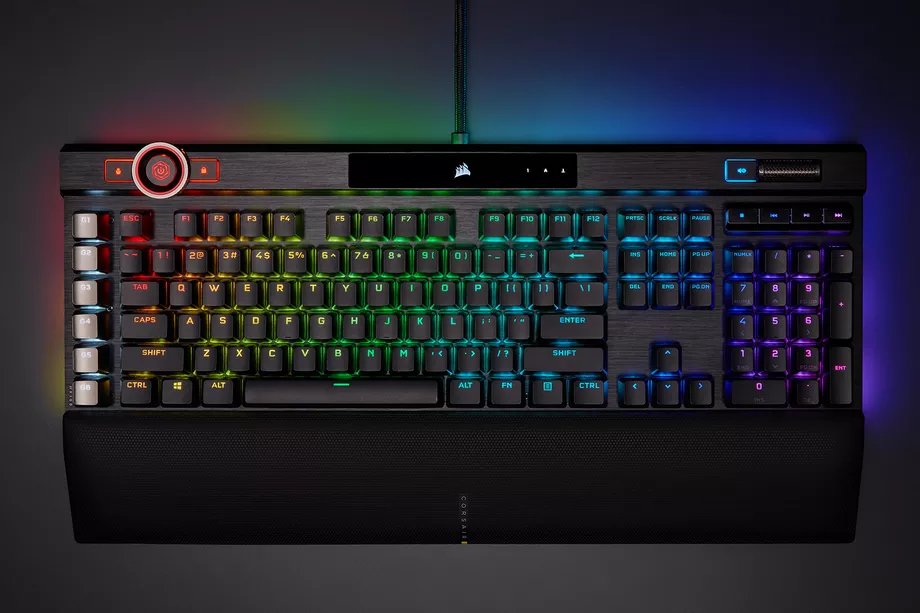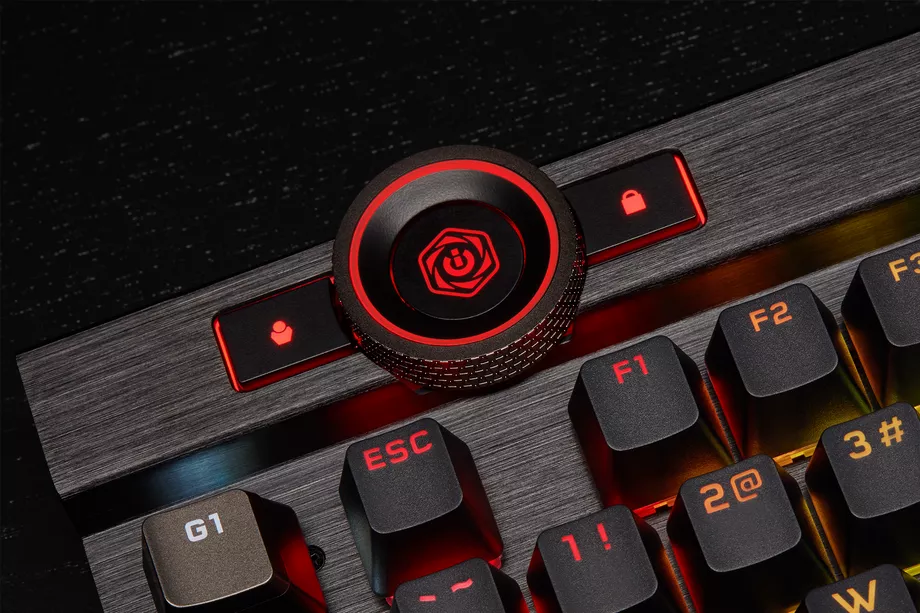I know you want to touch the dial
Corsair’s new $229.99 K100 is currently the company’s most expensive mechanical gaming keyboard. What lends to the high cost, in part, is the handy iCue control dial at its top left, which is so fun to use.
You might not notice the dial at first, as this keyboard’s highly customizable 44 zones of RGB LEDs are dazzling to look at, with new vents on both sides that give the light even more places to spill out onto your desk compared to its seeming predecessor, the K95 Platinum RGB. Corsair has you totally covered if you want to annoy your housemates to have a bright, bold keyboard.
But it’s the dial that most intrigues me, providing a ton of control over the keyboard itself as well as your PC.
THE ICUE DIAL MAKES THIS A VERSATILE KEYBOARD
During my time testing the K100, the dial offered up a satisfying way to control functions that usually require holding down multiple keys. I found myself repeatedly adjusting the backlight brightness, which thankfully lets you make the LEDs incredibly dim (a welcome feature to have if you’re like me and want just a little bit of light in your setup). The dial can be customized to the nines in the iCue software to perform a number of more practical commands, like skipping tracks in your music app, zooming in on or scrolling down a page, or switching applications entirely, like a glorified Alt+Tab function.
Each function you activate in the software is assigned to a color of your choosing, and you just press the button at the center of the dial to switch between them.
Corsair
To my knowledge, this is Corsair’s first keyboard to feature a multi-function dial like this (in addition to a new volume dial on the K100’s right side), and it’s reminiscent of the Surface Dial, Logitech’s Craft keyboard, and even the Griffin PowerMate. Who doesn’t love a good dial?
If you want to customize the keyboard even more, the iCue software is where you can save custom macro assignments (with support for the Elgato Stream Deck streaming accessory), your favorite backlighting arrangements and other settings to a profile that’s stored onto the keyboard’s 8MB onboard storage.
QUARTER OF A MILLISECOND
There are some big changes on the inside, including a new option to activate a 4,000Hz polling rate (improving over 1,000Hz) through the software for registering key presses at ludicrous speed. To put that into context, turning this feature on means the OS would check the keyboard for a new key press every quarter of a millisecond, as if anyone could type that quickly. Clearly, Corsair wants pro gamers to put faith in the responsiveness of the K100.
Aiding in that fast performance are Corsair’s new OPX optical switches that have a small 1mm actuation point, meaning you barely have to press at all to have them register. Each key has a 3.2mm travel, so they’re still satisfying to type on, and they apparently have “zero” debounce in the switch, which Corsair claims is better than mechanical switches in terms of delivering a clean and clear electrical signal to your PC. If you still prefer the feel of mechanical switches, though, Corsair is offering the K100 with Cherry MX Speed switches for the same $229.99 price.
Corsair
Corsair also claims that the optical switches will last longer than traditional mechanical switches, up to 150 million key presses over their lifetime. Razer’s current optical switches, like the ones in its Huntsman Mini tenkeyless, last up to 100 million clicks, so Corsair might have cracked the code for added longevity here. Or maybe they’re just hoping you’ll never find out because you’ll never press them that many times?
Rounding out the features, the K100 has flip-out feet on its bottom to adjust its overall height and angle, and Corsair includes a magnetic wrist rest in the box. Like most premium keyboards in this price range, the K100 also supports full n-key rollover with 100 percent anti-ghosting. This model also has a six-foot braided cable and one passthrough USB 2.0 port, and it’s compatible with Windows 10, macOS, and Xbox One.
Source: Paper.li







Comments